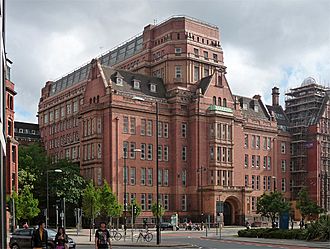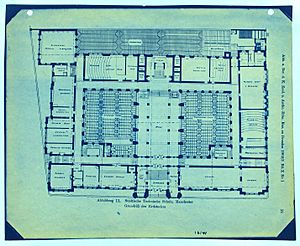Sackville Street Building facts for kids
Quick facts for kids Sackville Street Building |
|
|---|---|

The Sackville Street building from Whitworth Street/Aytoun Street
|
|
| Former names | UMIST Main Building |
| General information | |
| Status | Grade II |
| Type | Academic |
| Architectural style | French Renaissance |
| Town or city | Manchester |
| Country | England |
| Coordinates | 53°28′35″N 2°14′03″W / 53.4764°N 2.2342°W |
| Construction started | 1895 |
| Inaugurated | 1902 |
| Renovated | 1927–1957 |
| Owner | University of Manchester |
| Technical details | |
| Floor count | 12 |
| Renovating team | |
| Architect | Bradshaw Gass & Hope |
The Sackville Street Building is a large building in Manchester, England. It is located on Sackville Street. Today, the University of Manchester uses this building. Before 2004, it was the main building for a different university called UMIST.
Building work started in 1895. It was built for the Manchester School of Technology. The building opened in 1902. The Prime Minister at the time, Arthur Balfour, officially opened it. The school later became the Manchester Municipal College of Technology in 1918.
Contents
About the Sackville Street Building
The building is made from a special type of clay called terracotta. It is now a Grade II listed building. This means it is an important historical building. The building was made bigger between 1927 and 1957. This work was done by architects Bradshaw Gass & Hope. It took a long time because of the economic problems in the 1930s and World War II.
Inside the Building
Originally, there were plans for a swimming pool on the top floor. However, people worried the water would be too heavy. So, it became a gymnasium instead. Later, it was used as a hall for exams. The lower floors have many departments. One is the Royce Laboratory for engineering. It is named after Henry Royce.
The floors in the building are named with letters. The lowest floor is BA. Then, they go from A to L. The letter I is skipped.
Location and Features
The Sackville Street Building is surrounded by several streets. These include Whitworth Street, Granby Row, Cobourg Street, and Sackville Street. The main entrance is on Sackville Street. It is called the Grand Entrance. There is another common entrance on Granby Row. Students and staff can also use an entrance on Whitworth Street.
The Godlee Observatory is on the roof of the building. It is still used today for looking at the stars. The university uses the building for many things. This includes teaching, research in science and technology, and administrative offices. It is also used for exams.
Libraries and History
The Joule Library is located on floors D, E, and F. This library is now part of the University of Manchester Library. It also has offices, labs, and lecture halls. The Joule Library was named in 1987. It honors the famous physicist J. P. Joule.
There are special messages carved into the walls at the main entrances. These messages tell about important events in the building's history. Part of the building was built where an old church used to be. This was St Augustine's Church. There is also a plaque that remembers Ivan Levinstein's laboratory. His lab was once on this site.
What is the Building Used For Now?
The Sackville Street Building is currently home to the University of Manchester's School of Electrical and Electronic Engineering. This is often called EEE. It also has departments for textile sciences. The Dalton Institute for nuclear science is also located here.


